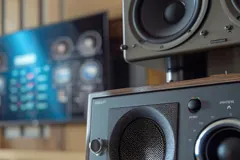![]() As an ADI Alliance design partner, Cardinal Peak has a wealth of experience with Analog Devices (ADI) components and software, particularly using SHARC, A2B, Catalina, Navassa and SigmaStudio. While we have used ADI parts in a variety of applications, we most commonly use these components in our networked audio designs where low latency is a must, such as in automotive audio, pro audio and teleconferencing applications. Our engineers are particularly experienced in the following:
As an ADI Alliance design partner, Cardinal Peak has a wealth of experience with Analog Devices (ADI) components and software, particularly using SHARC, A2B, Catalina, Navassa and SigmaStudio. While we have used ADI parts in a variety of applications, we most commonly use these components in our networked audio designs where low latency is a must, such as in automotive audio, pro audio and teleconferencing applications. Our engineers are particularly experienced in the following:
- A2B (AD2428, AD2401, …),
- SHARC processors (ADSP-SC584, ADSP-2158X, ADSP-SC2158x and ADSP-2146X, …),
- Software-Defined Radios (SDR) (Catalina AD9361,…), and
- SigmaStudio®
A2B Audio Design
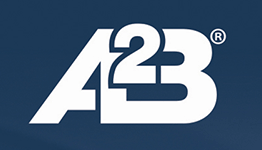
The Automotive Audio Bus (A2B) is a perfect complement to longer-range, low-latency audio buses, such as Audinate’s Dante or AES-67. A2B is no longer limited to just automotive applications since ADI started incorporating this extremely low-latency, virtually jitter-free bus into a range of their broad market parts in 2019. For real-time audio, such as any application with microphones and speakers, system latency must be minimized. A2B does a great job of minimizing latency on the wire, and Cardinal Peak has the expertise to ensure the rest of the data pipe and audio processing latency is also kept low. To read about four different A2B projects we have worked on, please see our case study A2B capabilities and experience.
SHARC Audio Processing
For low-latency audio networks, you need to ensure that your processing nodes do not present a bottleneck lest you get glitches in playback or introduce latency to the overall audio chain. Some of the tools we use for high-speed audio processing are SHARC and SHARC+ DSPs. Cardinal Peak has deep experience with SHARC audio processors/SoCs, such as the ADSP-SC584 and Griffin Lite and Ultra Lite, including ADSP-2158X, ADSP-SC2158x and ADSP-2146X series chips. These parts have combinations of SHARC and SHARC+ DSPs and ARM core processors.
SHARC Audio Product Design Examples
 Some examples of the types of SHARC work we have done in the past include:
Some examples of the types of SHARC work we have done in the past include:
- Developing software to manage both FIR and IIR filter accelerators in a multicore DSP SHARC (ADSPSC-2158x and ADSP-2158x) while sharing one FIR and IIR filter accelerator between multiple DSPs. We accomplished this using the Micrium OS and taking advantage of SHARC peripherals, such as the trigger routing units.
- Investigating how to reduce memory usage on SHARC platforms, freeing up more of the fast L1 memory to meet algorithm needs. Work included OS configuration through implementation of new drivers and software.
- Developing Simulink code replacement library (CRL)-based delay line models that operated using either fast L1 memory or slower L2 memory without impacting processing loads. L2 implementations were direct memory ccess (DMA) controller-based to avoid adding computation load to the DSP due to slower L2 memory.
- Developing a full audio platform on the Griffin Ultra Lite (ADSP-2146X) evaluation board to profile performance of newer FIR and IIR accelerators to determine if this chip would meet our customer’s needs for their DSP platform.
- Developing Simulink models that generated code to drive Griffin Ultra Lite target accelerators (CRL-based models).

Analog Devices Catalina & Navassa Experience
Beyond A2B and SHARC lines, we are experienced with ADI’s line of software-defined radio (SDR) transceivers, such as Catalina and Navassa. For example, we had one customer that needed an extremely low-latency (submillisecond) 10-channel bidirectional audio wireless link. We were able to develop a custom SDR with sub-ms latency using Analog Devices’ Catalina transceiver. Read more about our experience with SDR.
About Cardinal Peak’s Product Design Services
Cardinal Peak accelerates your product development with end-to-end design services for connected audio devices. A leading product engineering firm, Cardinal Peak leverages deep experience in hardware, embedded software, cloud, mobile applications and quality assurance to develop connected IoT products in multiple markets, including audio, video, security and medical.
Product Ideation
Developing differentiated products that disrupt markets
IoT Engineering
Designing products that integrate with mobile applications and cloud systems
Voice
Experts at embedding voice processing capabilities in connected devices
Quality Assurance
From black box testing to test automation and manufacturing support
Managed Services
IoT fleet management, network management, and tier 2 support
Sustaining Engineering
Cost effective sustaining engineering to keep your IoT products current and operating as underlying services change
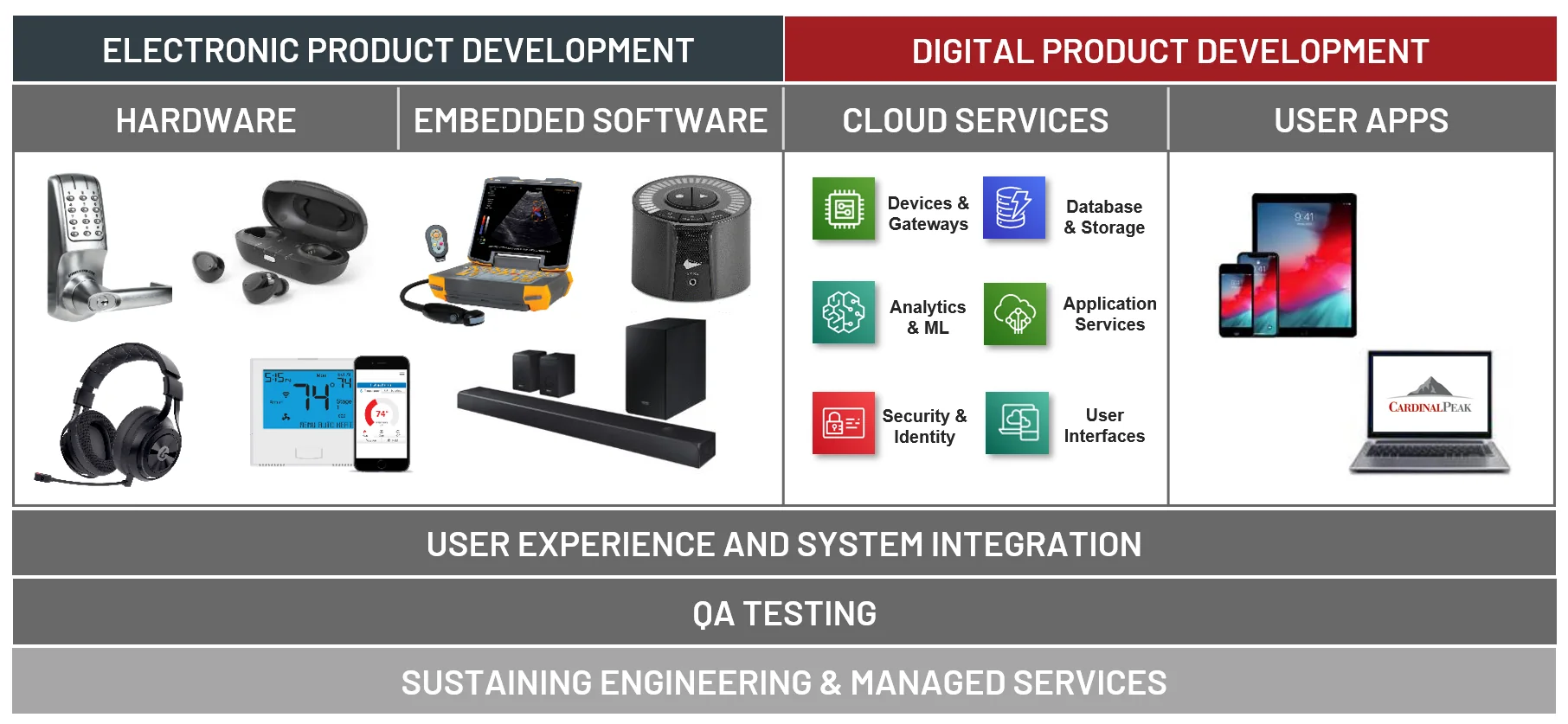
Audio Product Design Resources
Analog Devices Sharc & A2B Related Articles
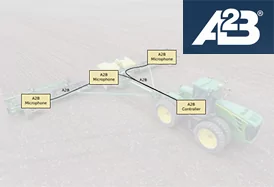
The Future of Fault Detection: A2B Technology for Automated Equipment
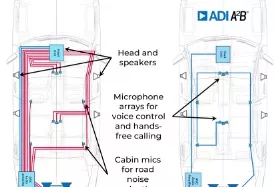
What is Analog Devices' Automotive Audio Bus (A2B) and How is it Used?
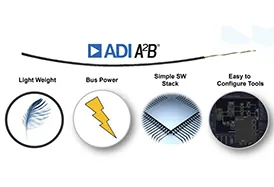
Unleashing A2B Technology for Conferencing, Live Audio and Other Applications
Analog Devices’ SHARC, A2B & Audio Product Design FAQs
What is the Best Way to Boost Performance When Using SHARC and SHARC+ SoCs?
Using the hardware peripherals on Analog Devices’ SHARC SoCs to the fullest extent is the best way to boost overall performance. While the main processor may be easier to code, you get the biggest performance boost by pushing tasks to the hardware peripherals.
What are Some Common Applications Where Audio Latency Plays an Important Role?
- Conference calling
- Auditoriums and classrooms
- Musical and stage performances
- Interactive gaming
When to Use A2B Vs. Audinate’s Dante?
While A2B is lower cost per node and supports daisy chain wiring (rather than hub and spoke), its range is far less than Audinate’s Dante. For this reason, if you have a cost-sensitive low-latency audio network requirement, we suggest using A2B for the local connections and Dante for the broader network, particularly if the daisy chain wiring saves significant installation or wiring costs.

